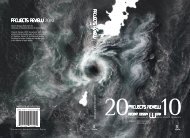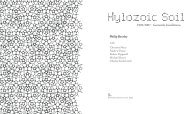The Inner Studio - Riverside Architectural Press
The Inner Studio - Riverside Architectural Press
The Inner Studio - Riverside Architectural Press
Create successful ePaper yourself
Turn your PDF publications into a flip-book with our unique Google optimized e-Paper software.
INTRODUCTION<br />
design and legislate for their survival. According to the World<br />
Watch Institute, by the end of this decade, for the first time, the<br />
majority of the earth’s citizens will live in cities. This should give<br />
us pause.<br />
Where we once lived in a symbiotic or harmonious relationship<br />
to our natural environment, today we live in a thoroughly built<br />
world in which we are rapidly losing the opportunity to gain the<br />
deeper self-knowledge that comes from observing the arising and<br />
passing away of natural things. Not only were we once part of<br />
nature, all the happenings of our inner world were considered<br />
“natural.” How can self-knowledge be extracted from the designed<br />
environment unless the designers themselves can consciously<br />
experience their own inner worlds and use these to promote selfknowledge?<br />
<strong>The</strong> purpose of psychology is to guide us through human problems<br />
and to help us make sense of our lives. Where we once<br />
prospered by studying the migration of animals, we now find<br />
ourselves struggling to know how we feel about ourselves and<br />
others. Clearly we live in a world that is both physical and psychological<br />
and we can no longer afford to leave out the complex,<br />
paradoxical, and often troublesome role of feelings that occur<br />
during the design process. Society has distinguished itself by<br />
its willingness to integrate new technologies–<strong>The</strong> <strong>Inner</strong> <strong>Studio</strong><br />
proposes using the self-knowledge and creativity that reside in our<br />
modern understanding of the psyche.<br />
Architects will often explain their work by saying that it has been<br />
“designed from within.” This usually means that we are designing<br />
from some rational appreciation of a building’s organization. I want<br />
to suggest a less intentional explanation, that there is a moment in<br />
the creative process that rests on a different kind of know-how, on<br />
the relationship we have to the inner world of our psyches. <strong>The</strong><br />
role of inner know-how, the world of instinct, imagination, and<br />
intuition, the world of subtlety and felt sense, is not only a complementary<br />
counterweight to our technical training and practical<br />
skills, it also represents a part of ourselves that needs to be<br />
respected and developed and included in the built world.<br />
3





